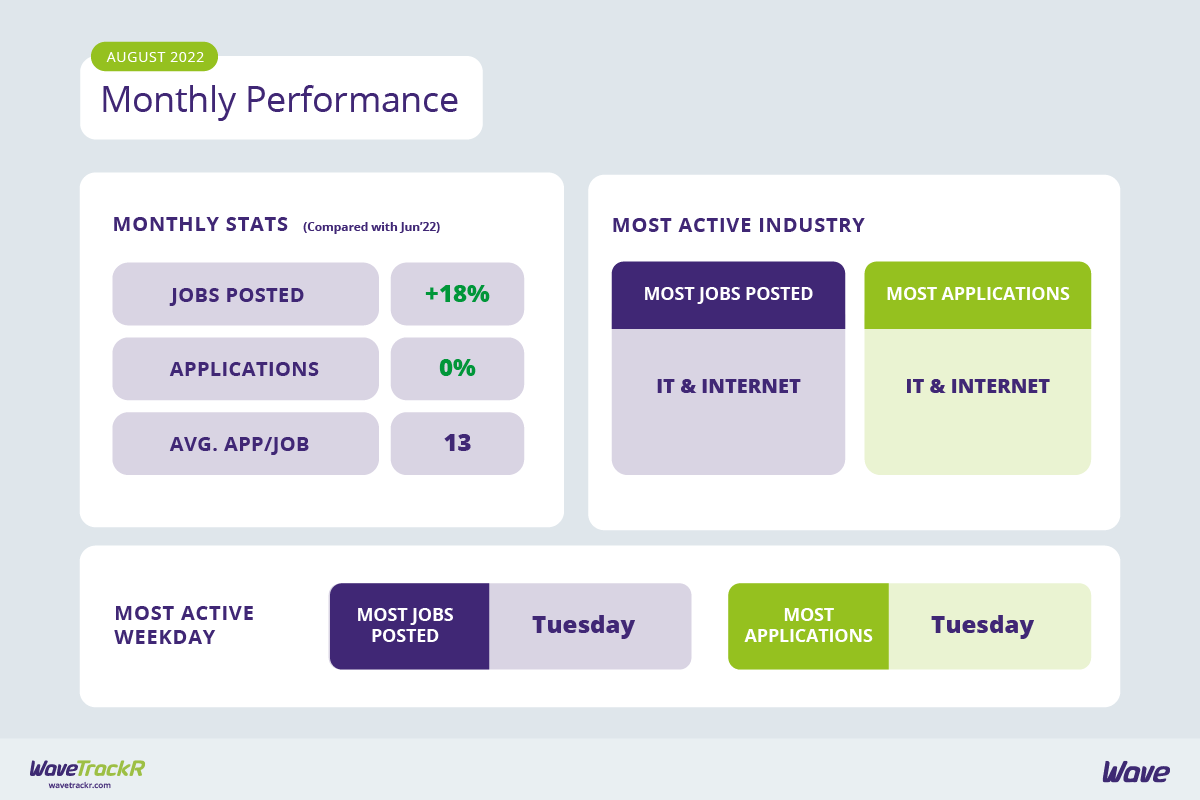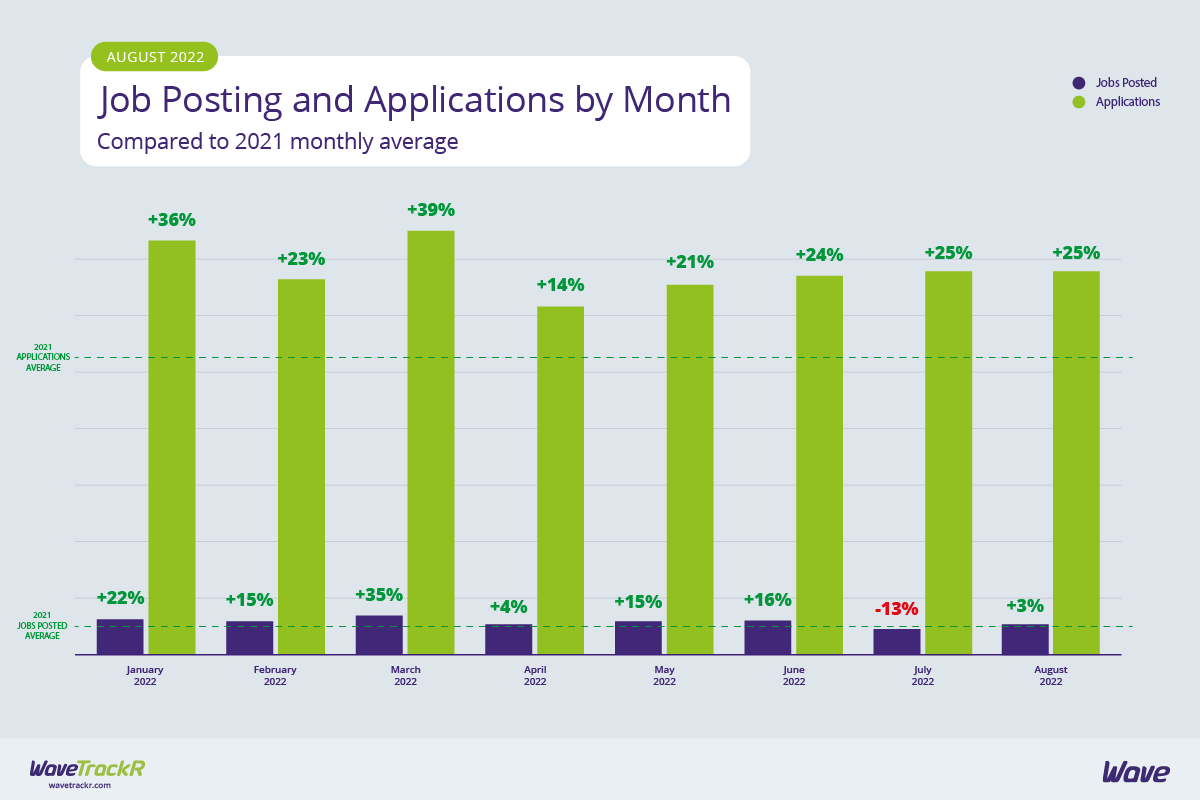After a significant fall in July, the WaveTrackR August 2022 Recruitment Trends Report showed that jobs increased by 18% from July to August. In what is usually a slow month, a rise in jobs is a positive sign - especially amidst mounting hiring caution in the face of soaring costs. Applications, meanwhile, have plateaued over the past couple of months, which is a seasonal summer trend. However, as the cost of living crisis deepens we are likely to see applications increase as real wages continue to fall.
Following a month where we saw jobs dip below the 2021 monthly average for the first time this year, it was reassuring to see that job posting in August was decidedly healthier. At 3% over the 2021 monthly average, it still ranks as the second lowest figure of 2022 to date, but considering that is an 18% increase on July, it means August was far more active. Given the annual trend for August is a slow-down in general job activity due to both recruiters and candidates being on holiday, this is a strong sign - even more so when you consider the current climate, with many businesses taking a cautionary approach to hiring thanks to rising costs.
At a 0% increase in August and just a 1% increase in July, applications have plateaued but, again, this is an annual summer trend when active candidates take time out to reassess, passive candidates start to re-think their career choices whilst on holiday, and working parents wait until September when schools are back to make any big life changes. As a result of the increase in jobs but not in applications, the average number of applications per job has fallen from 15 in July to 13 in August.
As always, different industries have their own stories. IT & Internet remains incredibly strong, posting the highest percentage of jobs and receiving the highest numbers of applications across all industries for the fourth consecutive month. The industry received an incredible 28% of all applications for the second month in a row and posted 25% of all jobs. Health & Nursing and Education posted the second and third highest number of jobs but didn’t receive correlating numbers of applications. For Health & Nursing, this is down to a historic skills shortage that the industry has long struggled to overcome.
Education seems to experience activity in waves, with high levels of applications during the pandemic when many wanted to shift into a job that helped people, but is now recording relatively low numbers. The industry received amongst the lowest average numbers of applications per job - just 5 compared to the all-industry average of 13. The Office for National Statistics revealed job vacancies in the Education sector are at a 20 year high. Why? The cost of living crisis has highlighted the poor pay of many teaching staff, including support staff. Add to that greater flexibility post-COVID in other sectors and heavy workloads and Education is struggling to both retain and recruit.
On the flip side, at 18, Construction received one of the highest average numbers of applications per job. The industry experienced a decline in jobs over the summer thanks to supply chain issues and the very real risk of recession affecting projects. Albert Manifold, CEO of CRH, the world’s largest building materials company, spoke to the Financial Times, warning of a “second wave of cost increases” as soaring energy costs push up the costs of wages and logistics. As projects are put on hold or scrapped altogether because re-costing makes them too expensive, plus the inevitable slow-down in extensions as people tighten their belts over the next few months, candidates are finding job opportunities decreasing.
Notable for its absence on the report’s lowest average number of applications per job chart this month is Travel, Tourism & Leisure. The industry - one of the worst hit during the pandemic and then hit again by labour shortages - received an average of just 2 applications per job in July. However, following the very public travel issues over the summer, the recruitment drive and subsequent training times seem to be quickening pace.
For those industries with difficult-to-fill, niche jobs, the way to access more candidates seems to be to post to niche job boards. Secs in the City yet again dominates when it comes to providing the highest average numbers of applications per job across the job boards. At 21, it provided recruiters with 5 more than the next highest - Caterer with 16, another niche job board. Totaljobs tops the generic job boards at 15 - 10 more than both Reed.co.uk and CV-Library. Niche job board CW Jobs achieved an average of 14 applications per job.
August is one of those months where low applications or job posts could just be down to it being a slow time of year. Jobs and applications figures for September and October - traditionally more active months, but also when energy bills are set to soar once more if the new price cap goes ahead - will be very interesting to see. Top tip to reach more candidates, whatever the state of the market? Tuesday is an incredibly active day in the recruiting world - it is the day most jobs are posted and the day that most applications are sent, proof that getting those jobs in front of candidates when they are actively searching is essential. Post your jobs at the beginning of the week and you are far more likely to get a great response from candidates.








